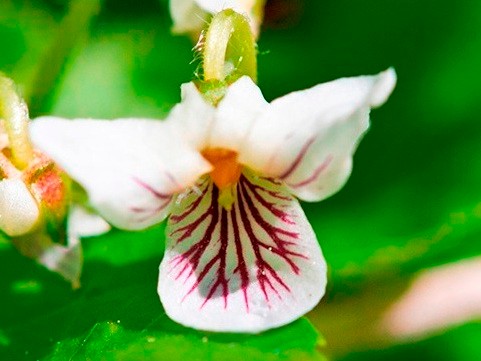Kidneyleaf violet
(Viola renifolia)

Description
Viola renifolia is a species of violet known by the common names white violet and kidneyleaf violet. It is native to northern North America, where it has a widespread distribution across Canada and the northern United States as far south as Washington, Colorado, and New York. Kidneyleaf violet is a perennial herb growing up to 10 centimeters tall. It does not have stems, rhizomes, or stolons. The kidney-shaped leaf blades are 3 to 6 centimeters long and are borne on petioles up to 15 centimeters long. The flower is 1 to 1.5 centimeters long and white in color with purple lines on the lower three petals. The fruit is a purplish capsule. This violet grows in white spruce and black spruce forests, and temperate coniferous forests. Near the Great Lakes it grows in swamps and wooded areas. It is listed as endangered in Connecticut, as threatened in Iowa, as extirpated in Pennsylvania, and as sensitive in Washington. Viola is a genus of flowering plants in the violet family Violaceae. It is the largest genus in the family, containing between 525 and 600 species. Most species are found in the temperate Northern Hemisphere; however, some are also found in widely divergent areas such as Hawaii, Australasia, and the Andes. Some Viola species are perennial plants, some are annual plants, and a few are small shrubs. Many species, varieties and cultivars are grown in gardens for their ornamental flowers. In horticulture the term pansy is normally used for those multi-colored, large-flowered cultivars which are raised annually or biennially from seed and used extensively in bedding. The terms viola and violet are normally reserved for small-flowered annuals or perennials, including the wild species. Annual or perennial caulescent or acaulescent (with or without a visible plant stem above the ground) herbs, shrubs or very rarely treelets. In acaulescent taxa the foliage and flowers appear to rise from the ground. The remainder have short stems with foliage and flowers produced in the axils of the leaves (axillary). Viola typically have heart-shaped or reniform (kidney-shaped), scalloped leaves, though a number have linear or palmate leaves. The simple leaves of plants with either habit are arranged alternately; the acaulescent species produce basal rosettes. Plants always have leaves with stipules that are often leaf-like. The flowers of the vast majority of the species are strongly zygomorphic with bilateral symmetry and solitary, but occasionally form cymes.
Taxonomic tree:







